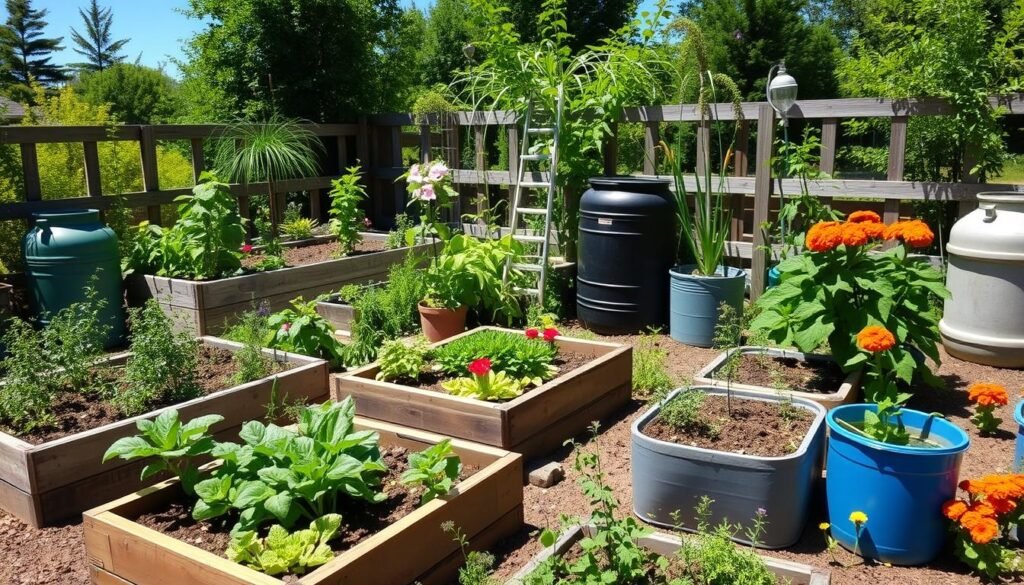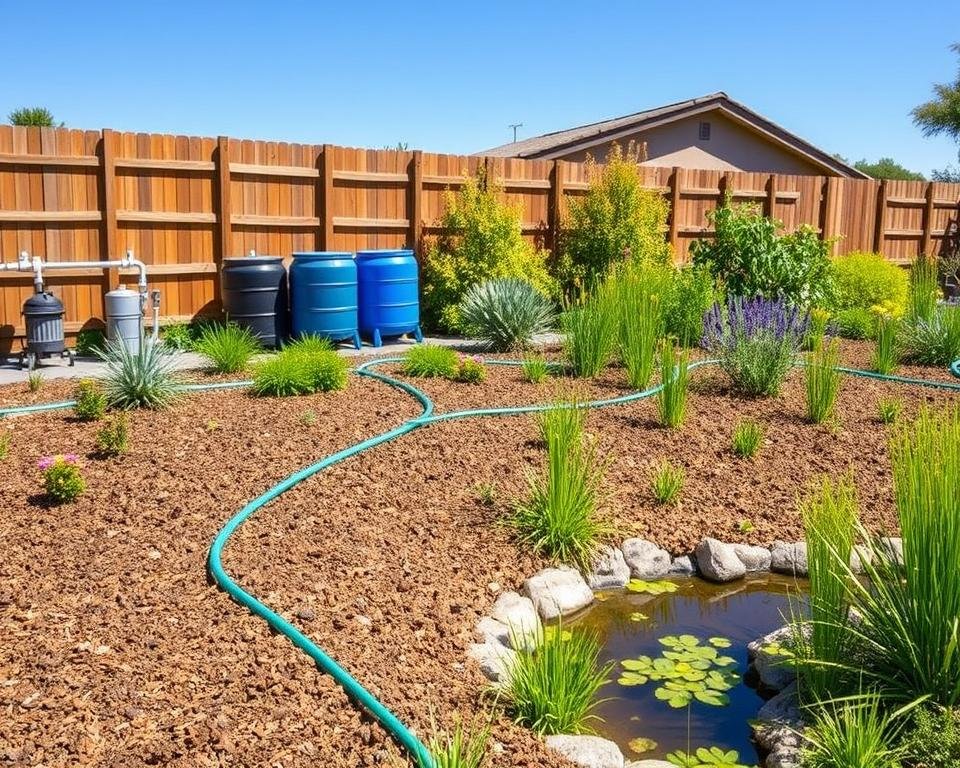Did you know that the health of our ecosystems relies heavily on pollinators? Creatures like bees, butterflies, and hummingbirds are vital to nature’s balance. However, their numbers are dwindling rapidly. It’s imperative for us to act and create gardens that support these crucial pollinators.
This guide will show you how to turn your outdoor area into a lively, buzzing haven for pollinators. You’ll learn about choosing the right flowers and plants, setting up water sources, and creating safe spaces. By doing so, you’ll not only beautify your surroundings but also boost your local ecosystem’s health.
Understanding Pollinators’ Importance
Pollinators are crucial for the balance of our ecosystems. Bees, butterflies, and other insects are key to many plants’ reproduction. This includes the fruits and vegetables we eat. Their role is vital for the health of our planet’s diverse flora.
Their Role in Ecosystem Balance
Pollinators are the unsung heroes of nature. They connect plants with animals that depend on them. By moving pollen, they help plants reproduce, ensuring essential resources continue. Without them, many food crops and wildflowers would disappear.
The Alarming Decline of Pollinators
Pollinators are facing a significant decline due to threats like habitat loss, pesticide use, and climate change. This decline threatens the balance of our ecosystems. It has serious consequences for both nature and human society.
Understanding pollinators’ role is key to creating a garden that supports them. By making our gardens pollinator-friendly, we help maintain ecosystem health. This ensures the continued well-being of our shared environment.
Tips for Attracting Bees, Butterflies, and Other Pollinators to Your Garden with
Creating a pollinator-friendly garden is a rewarding endeavor. It can transform your outdoor space into a haven for bees, butterflies, and other essential creatures. By following these practical tips, you can invite these vital pollinators to thrive in your garden. They play a crucial role in maintaining the delicate balance of our ecosystem.
One of the most effective ways to attract pollinators is by incorporating a diverse array of nectar-rich flowers throughout your garden. Choose a mix of plants that bloom at different times, ensuring a continuous food source for your winged visitors. Native wildflowers are particularly valuable, as they are adapted to the local climate and provide the most nourishment for native pollinators.
In addition to flowering plants, consider incorporating host plants that serve as a food source for caterpillars, the immature stage of many butterfly species. These plants, such as milkweed for monarch butterflies, offer a complete life cycle for pollinators. This allows them to thrive and reproduce in your garden.
Providing a reliable water source is another essential element in creating a pollinator-friendly haven. A shallow birdbath, a small pond, or even a dripping faucet can offer the hydration that pollinators need. Remember to include stones or branches that allow them to access the water safely.
Finally, avoid the use of pesticides and herbicides in your garden, as these chemicals can be detrimental to pollinators and disrupt the delicate balance of the ecosystem. Instead, embrace natural pest control methods and hand-pull weeds to maintain a healthy, chemical-free environment for your winged visitors.
| Tip | Description |
|---|---|
| Plant Diverse Nectar-Rich Flowers | Choose a mix of plants that bloom at different times, ensuring a continuous food source for pollinators. |
| Incorporate Host Plants | Include plants that serve as a food source for caterpillars, the immature stage of many butterfly species. |
| Provide Water Sources | Offer a reliable water source, such as a shallow birdbath or a small pond, to hydrate your pollinator guests. |
| Eliminate Pesticides and Herbicides | Adopt natural pest control methods and hand-pull weeds to maintain a healthy, chemical-free environment. |
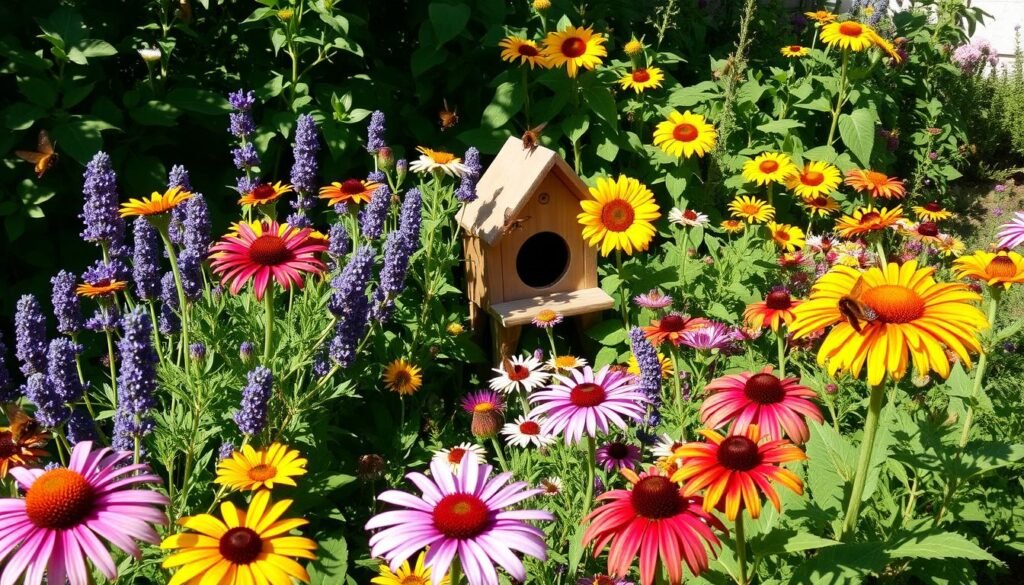
By implementing these tips, you can transform your garden into a thriving pollinator haven. This supports the vital role these creatures play in maintaining the delicate balance of our ecosystem. Embrace the joy of watching your garden come alive with the flutter of wings and the hum of busy pollinators.
Choosing Nectar-Rich Flowers
In the quest for a pollinator-friendly garden, the selection of flowers is paramount. Opting for nectar-rich, native wildflowers is essential to draw in a variety of bees, butterflies, and other vital pollinators. These plants offer a steady food source all season long. They also boost your garden’s health and aesthetic appeal.
Native Wildflowers for Pollinators
Native wildflowers stand out for pollinators due to their local climate and ecosystem adaptation. They’ve formed symbiotic bonds with native species, making them a top choice for food. Your garden can flourish with native, nectar-rich wildflowers such as:
- Coneflowers (Echinacea spp.)
- Milkweed (Asclepias spp.)
- Blanket Flower (Gaillardia spp.)
- Black-Eyed Susan (Rudbeckia spp.)
- Bee Balm (Monarda spp.)
These plants not only offer nectar for adult pollinators but also host their larvae. This ensures a complete life cycle for these vital creatures.
| Flower | Bloom Time | Pollinator Attraction |
|---|---|---|
| Coneflowers | Summer to Fall | Bees, Butterflies, Hummingbirds |
| Milkweed | Summer | Monarch Butterflies, Bees |
| Blanket Flower | Summer to Fall | Bees, Butterflies, Moths |
| Black-Eyed Susan | Summer to Fall | Bees, Butterflies, Beetles |
| Bee Balm | Summer | Bees, Hummingbirds |
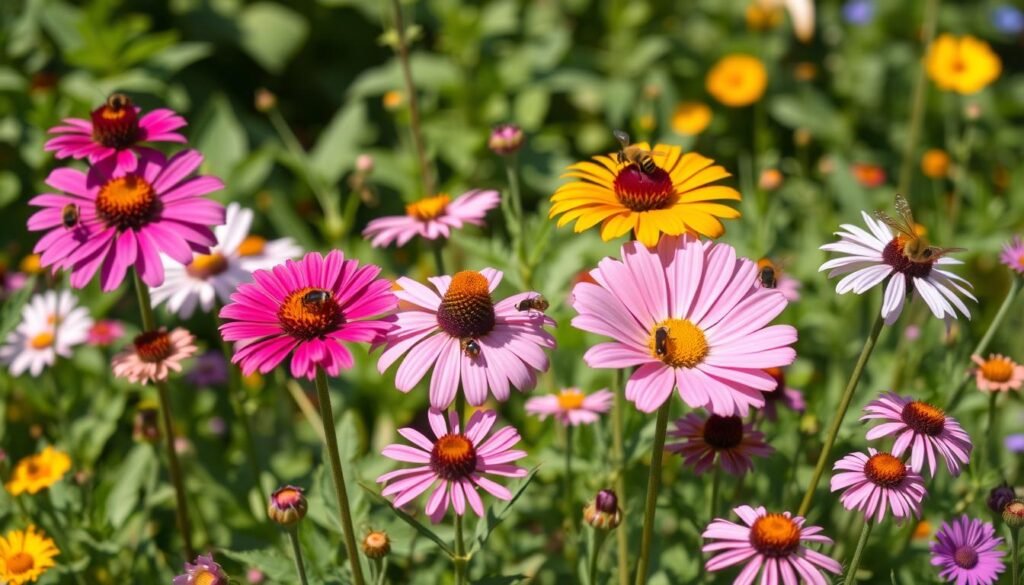
By integrating a mix of these nectar-rich, native wildflowers into your garden, you’ll create a vibrant, pollinator-friendly haven. This oasis will support the local ecosystem and elevate your outdoor space’s natural beauty.
Providing Host Plants for Caterpillars
Creating a pollinator-friendly garden goes beyond just nectar-rich flowers. It’s crucial to include host plants for caterpillars, the larval stage of butterflies. These plants are essential for their growth and provide a safe environment for them to complete their life cycle.
By adding host plants to your garden, you support the butterfly life cycle from egg to adult. This ensures a continuous presence of these pollinators and maintains a healthy ecosystem. Caterpillar-friendly gardening is key to creating a diverse and vibrant outdoor space that celebrates nature’s wonders.
Caterpillar-Friendly Host Plants
When choosing host plants, consider the specific needs of the butterflies you want to attract. Different species require different host plants. It’s vital to research native plants and those favored by local butterflies.
- Milkweed (Asclepias spp.) – Essential for the survival of Monarch butterflies
- Dill, Parsley, and Fennel – Host plants for Black Swallowtail butterflies
- Passionflower (Passiflora spp.) – Supports the life cycle of Gulf Fritillary and other Fritillary butterflies
- Lantana (Lantana camara) – Provides food and shelter for a variety of butterfly larvae
By incorporating a variety of host plants, you create a butterfly haven. This supports their life cycles and contributes to your local environment’s ecological balance.

| Butterfly Species | Host Plants |
|---|---|
| Monarch | Milkweed (Asclepias spp.) |
| Black Swallowtail | Dill, Parsley, Fennel |
| Gulf Fritillary | Passionflower (Passiflora spp.) |
| Painted Lady | Thistles, Mallows, Hollyhocks |
Establishing Water Sources
Creating a reliable water source is key to attracting and keeping a healthy population of pollinators in your garden. Bees, butterflies, and other pollinating insects need a steady water supply to stay healthy. This is crucial for their role in the ecosystem.
To make a pollinator-friendly water feature, consider different water sources. Options include:
- Shallow birdbaths or dishes filled with water and stones or pebbles for perching
- A small, gently sloping water garden or pond with a shallow edge for easy access
- A dripping faucet or mister that provides a steady source of hydration for bees and butterflies
When designing your water features, keep the water clean and refresh it often. This prevents algae buildup and stagnation. Also, place water sources in a partially shaded area. This maintains a comfortable temperature for your pollinator visitors.
By adding water sources for pollinators to your garden, you’ll provide essential hydration for bees and butterflies. You’ll also create a beautiful and pollinator-friendly water feature. This will attract a wide variety of these vital creatures to your outdoor space.
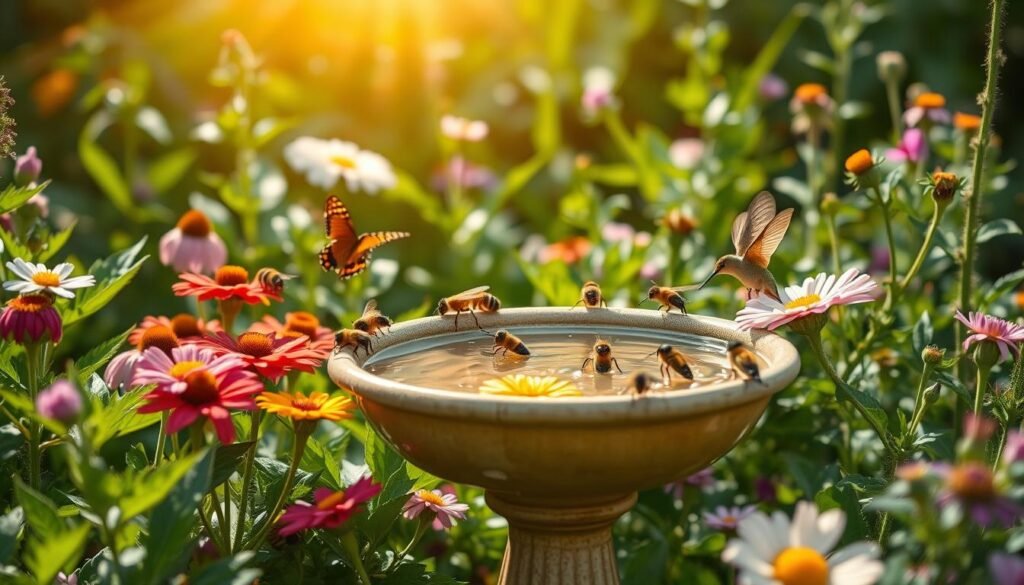
Incorporating Bee Houses and Nesting Sites
As you develop a pollinator-friendly garden, think about adding bee houses and nesting sites. These elements offer crucial shelter and breeding areas. They enhance the garden’s food and water offerings.
Different Types of Bee Houses
Exploring the various bee house types and their features is essential. Each design meets the needs of specific bee species. Selecting the right one can significantly benefit your local pollinators.
- Wooden Bee Houses: These structures have hollow tubes or drilled holes, mimicking natural nesting sites. They protect solitary bees, vital pollinators.
- Bamboo Bee Houses: Like wooden ones, bamboo houses are sustainable and natural-looking. Their hollow stems are perfect for many solitary bee species.
- Clay Bee Houses: Fired clay houses are durable and weatherproof. Their rough texture and small cavities attract various solitary bees.
- Straw Bee Houses: Made from bundled straw, these houses add charm to gardens. The straw tubes are ideal for solitary bees.
| Bee House Type | Key Features | Suitable Bee Species |
|---|---|---|
| Wooden Bee House | Hollow tubes or drilled holes | Mason bees, leafcutter bees |
| Bamboo Bee House | Hollow bamboo stems | Mason bees, leafcutter bees |
| Clay Bee House | Rough, porous texture with small cavities | Mason bees, leafcutter bees |
| Straw Bee House | Bundled straw tubes | Mason bees, leafcutter bees |
By adding diverse bee houses and nesting sites, you create a sanctuary for solitary bees and pollinators. This boosts your garden’s biodiversity and ecological balance.
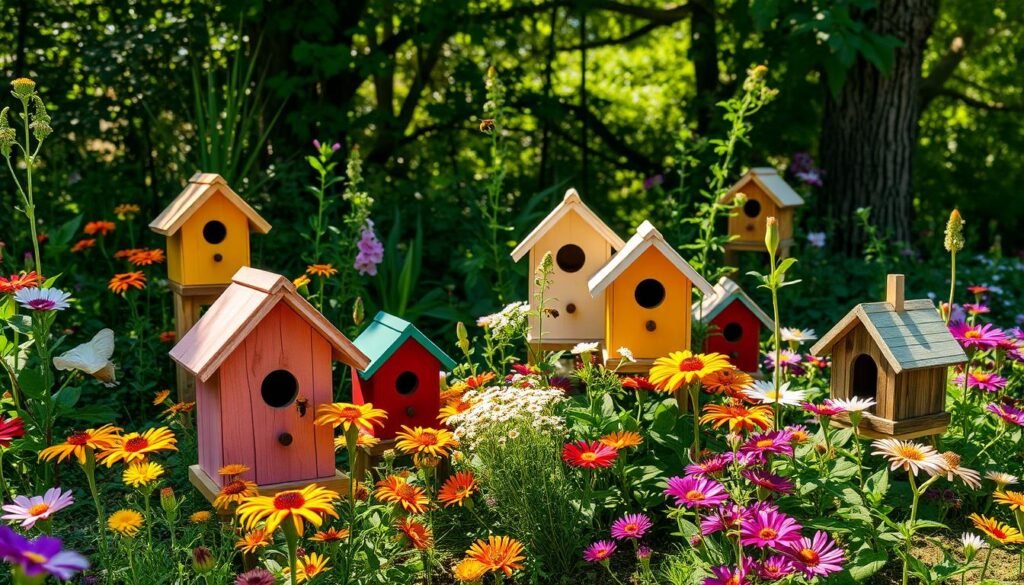
Practicing Pesticide-Free Gardening
To keep a garden thriving and welcoming to pollinators, one must commit to pesticide-free gardening. It’s crucial to steer clear of synthetic pesticides, herbicides, and insecticides. These chemicals can harm pollinators and disrupt the garden’s ecosystem. Instead, adopt organic gardening techniques and seek out natural pest control methods. This approach fosters a sustainable environment for your garden’s pollinators.
Protecting pollinators effectively involves reducing chemical use in your garden. Choose organic, non-toxic solutions that target pests without harming beneficial insects. This can include introducing natural predators, applying repellents, and promoting biodiversity. Such actions help maintain a natural balance in your garden.
By choosing pesticide-free gardening, you safeguard the pollinators crucial to your garden’s health. This practice also benefits the broader protection of pollinators in your area. It supports a vibrant, thriving garden while preserving the ecosystem’s delicate balance.
- Avoid synthetic pesticides, herbicides, and insecticides
- Embrace organic gardening methods
- Explore natural pest control alternatives
- Reduce chemical use to protect pollinators
- Contribute to the overall protection of pollinators in your local environment
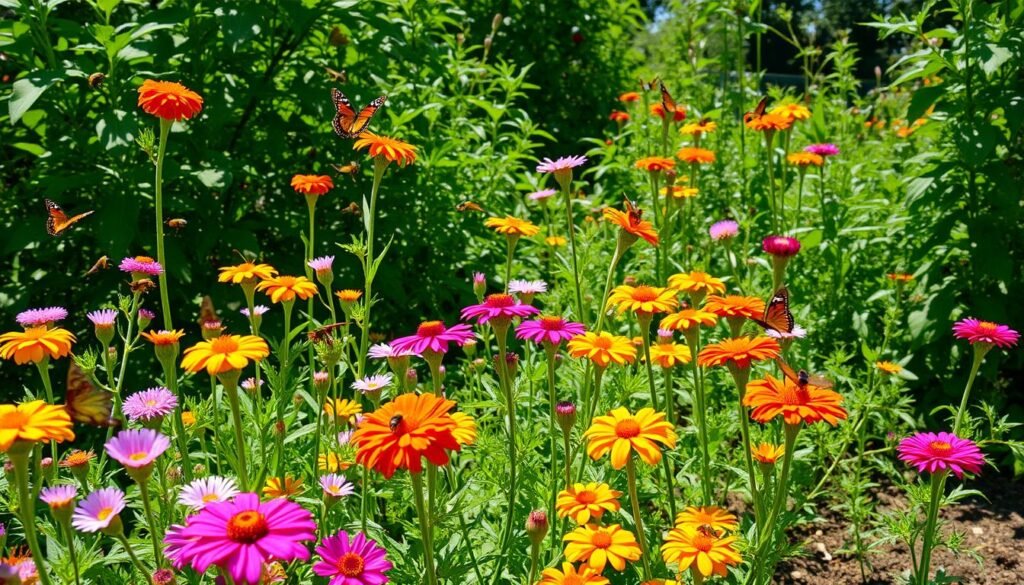
Conclusion
By following the strategies and tips in this guide, you can turn your garden into a vibrant, buzzing oasis. This oasis will support a wide variety of pollinators. By planting nectar-rich flowers, providing water, and creating nesting sites, you play a crucial role. This role is vital in creating a thriving ecosystem that benefits both pollinators and your local environment’s health.
Start your journey to create a pollinator-friendly garden and see your outdoor space transform. As bees, butterflies, and other pollinators thrive in your garden, take pride in your role. You’re contributing to the preservation of these essential species and maintaining ecological balance.
A pollinator-friendly garden not only attracts a variety of life but also shows your dedication to environmental stewardship. By creating a haven for these vital creatures, you’re enhancing your backyard’s beauty. You’re also making a significant impact on the broader ecosystem. Let your garden be a beacon of how small actions can greatly support the pollinators crucial to our planet’s health.
FAQ
What are the most important tips for attracting bees, butterflies, and other pollinators to my garden?
To draw in a variety of pollinators, focus on planting nectar-rich, native wildflowers. Also, ensure reliable water sources and create nesting sites. Lastly, avoid harmful pesticides. These steps can turn your garden into a vibrant pollinator haven.
What types of plants are best for attracting pollinators?
Native wildflowers, butterfly bushes, and other nectar-rich plants are top picks. They offer a steady food source and support the local ecosystem. These plants are essential for attracting bees, butterflies, and other pollinators.
How can I provide water for the pollinators in my garden?
Creating water features like birdbaths, shallow dishes, or small ponds is key. These should be shallow and have stones for safe landing. This ensures pollinators have a reliable hydration source.
What is the importance of providing host plants for caterpillars?
Incorporating host plants for caterpillars is vital for butterfly life cycles. These plants provide essential food and a safe place for egg-laying and caterpillar development. They are crucial for the complete life cycle of butterflies.
Why is it important to avoid using pesticides in a pollinator-friendly garden?
Synthetic pesticides, herbicides, and insecticides are toxic to pollinators. They disrupt the ecosystem’s balance. To protect bees, butterflies, and other pollinators, it’s crucial to garden without pesticides.
What types of bee houses or nesting sites can I provide in my garden?
Various bee houses are available, including wooden blocks, hollow stems, and simple soil mounds. These structures offer shelter and breeding grounds for solitary bees and other pollinators.
